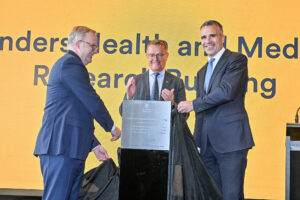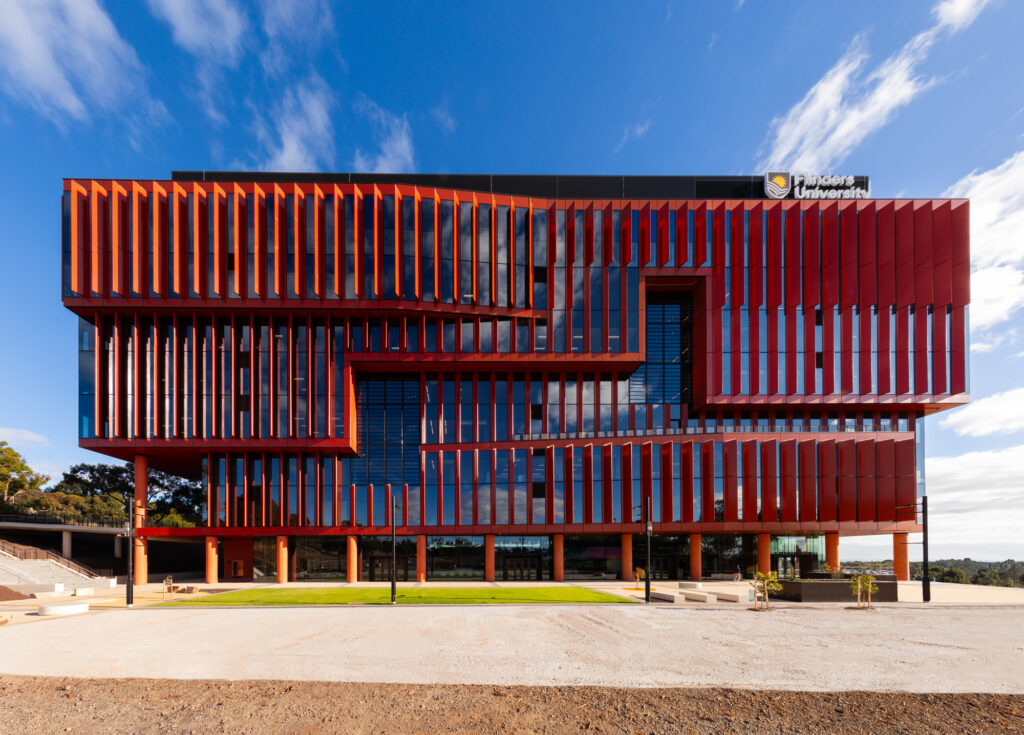
Flinders University has unveiled its cutting-edge Health and Medical Research Building (HMRB), marking a transformative new chapter for health and medical research in South Australia.
Home to over 600 medical researchers, clinicians, and support staff, the $280 million, ten-storey landmark is poised to tackle the most pressing health challenges of our time, from chronic diseases and Indigenous health disparities to pioneering treatments for diabetes, infections, and cancers.
Vice-Chancellor Professor Colin Stirling was joined by Prime Minister Anthony Albanese and South Australian Premier Peter Malinauskas in opening the HMRB, which has been purpose-built to foster collaboration among researchers, healthcare professionals, and industry partners to drive advances in medical science.

Located adjacent to Flinders Medical Centre and Flinders Private Hospital, the HMRB anchors the Flinders Village development – southern Adelaide’s biomedical research precinct that brings together research, education, and accommodation, driving $1.5 billion in economic activity and sustaining over 20,000 jobs, both directly and indirectly.
 HMRB is equipped with state-of-the-art cell imaging equipment and one of South Australia’s largest banks of PC2-rated physical containment labs across five floors, together with BC2 biosecurity containment zones. The building is one of Australia’s most sustainable research institutions and is the first medical research facility in the world to achieve a coveted platinum rating for best-in-class digital connectivity.
HMRB is equipped with state-of-the-art cell imaging equipment and one of South Australia’s largest banks of PC2-rated physical containment labs across five floors, together with BC2 biosecurity containment zones. The building is one of Australia’s most sustainable research institutions and is the first medical research facility in the world to achieve a coveted platinum rating for best-in-class digital connectivity.
The facility has been designed with, and to serve, Aboriginal and Torres Strait Islander peoples.
With a heritage spanning over 50 years in health and medical education, Flinders University pioneered integrated healthcare as Australia’s first university integrated into a public hospital.
This legacy of innovation has catapulted Flinders to become Australia’s fastest-growing research institution, with a 140% surge in research income in just five years. Notably, Flinders ranks eighth nationally for National Health and Medical Research Council (NHMRC) grants, a testament to its dedication to advancing global health.

Flinders University Vice-Chancellor Professor Colin Stirling said the HMRB is a game-changer in medical research, turning breakthrough research and clinical trials into real benefits for Australians in disease prevention and treatment.
“Flinders is redefining healthcare. This state-of-the-art facility will drive collaboration and empower our researchers and students to push the boundaries of medical innovation.”
“HMRB is a major leap forward, building on Flinders’ 50-year legacy of health innovation. It supports our rapid research growth and paves the way for discoveries that solve challenges and improve lives.”
Prime Minister Anthony Albanese said Flinders University’s Health and Medical Research Building will be making breakthroughs and changing lives for the better for many generations to come.
“I’m incredibly excited to see history being made at the HMRB – whether it’s better understanding neural pathways to control chronic pain, unravelling the secrets in our DNA to address debilitating genetic conditions, supporting the health of mothers and babies – there are endless possibilities to what the 600 researchers here will be able to achieve.”
“When I speak about a Future Made in Australia – this is what it looks like. Australian research, hard work and ingenuity keeping us at the global cutting edge.”
Premier Peter Malinauskas said boosting the quality and volume of research undertaken in South Australia is fundamental to increasing the complexity of our economy.
“This is the key to unlocking a better standard of living for all South Australians. To this end, Flinders University is a leader. It has posted the strongest growth rate in research income of any university in the country across the past five years.
“But more than that, the research undertaken at this incredible new facility will help save lives.”
“The proximity of this new building alongside the Flinders Medical Centre will provide opportunities for researchers to work alongside our clinicians and their patients to tailor safe and effective treatments and get them into use.”
Flinders University Deputy Vice-Chancellor (Research) Professor Ray Chan says Flinders is excited to see HMRB become a global centre for scientific discovery and medical advancements through research and clinical trials that are translated into tangible benefits for Australians seeking prevention, treatment and care – particularly First Nations peoples.
“By fostering collaboration and nurturing Flinders talent, HMRB will push the boundaries of healthcare advancement and our research-based students will be equipped to achieve the highest outcomes with a unique research approach and international collaboration that’s only possible in a state-of-the-art building.”
“HMRB supports our impressive research growth trajectory – over the last 5 years Flinders’ research income has grown by over 140% and the launch of HMRB will underpin impactful future discoveries that are solving challenges, driving social and economic growth and supporting better lives for Australians.”






